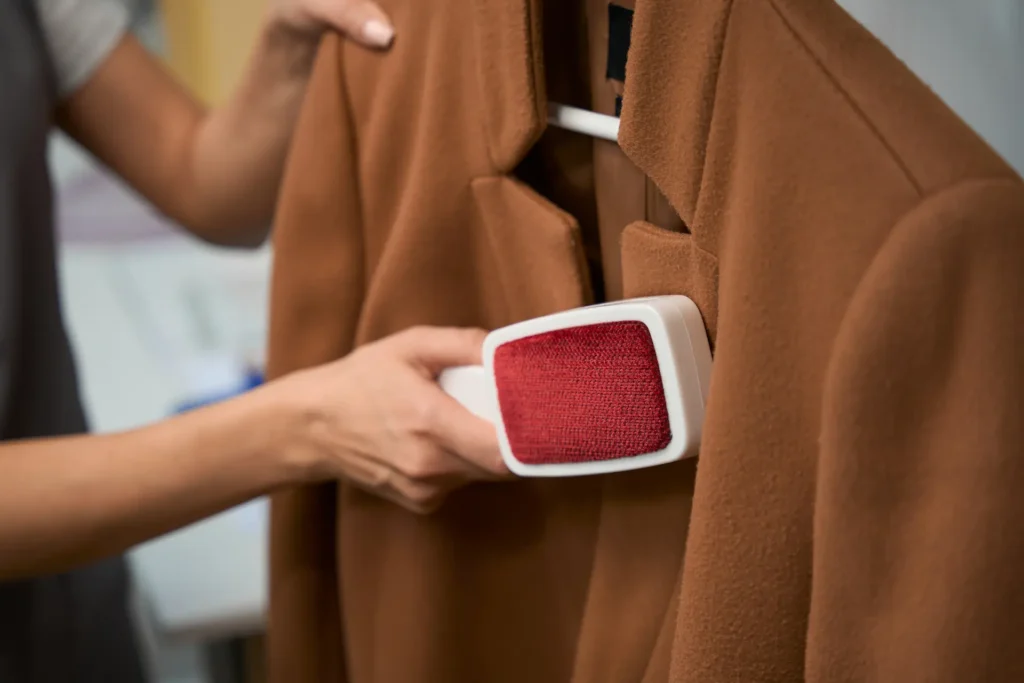Suits are the go-to choice for looking professional and polished, helping you make a great impression in any formal setting. Whether you own a custom-tailored suit or an off-the-rack suit, proper care and maintenance are crucial in preserving its appearance and extending its lifespan.
This comprehensive guide delves into the essential techniques for cleaning and storing your suit, giving you the knowledge to keep your suit looking its best.
Regular Brushing Your Suit
Investing in a suit brush is vital when it comes to suit maintenance. A suit brush will help to remove any surface-level dust and dirt before they can become embedded in the fabric. This process not only preserves the fabric’s appearance but also prevents premature wear and tear. This is because surface dust and dirt dulls the fabric’s appearance and, over time, abrade the fibres, leading to thinning and tears.
Brushing also helps prevent stains from setting in by removing loose particles that can trap moisture and oils, creating a breeding ground for stains. Additionally, brushing maintains the fabric’s nap, the raised surface that gives it texture and sheen.

To properly brush your suit
- Choose a soft-bristled clothes brush made from natural fibers like horsehair or boar bristles.
- Brush gently in the direction of the fabric’s nap to avoid ruffling the nap and causing the fabric to appear dishevelled.
- Focus on high-traffic areas, such as the shoulders, elbows, and seat of the trousers
- Make brushing a habit after each wear to prevent dirt and dust from settling into the fabric.
While alternatives like lint rollers and handheld steamers can provide some benefits, they are less effective at dislodging embedded particles and maintaining the fabric’s nap.
Spot Cleaning Your Suit
Accidents happen but quick attention to stains is crucial to prevent them from setting and causing permanent damage. The longer a stain sits, the harder it is to remove. Spot cleaning your suit helps avoid damage by reducing the need for harsh chemicals, as they can bleach or damage delicate suit fabrics.

- To properly spot clean, act quickly by blotting the stain gently with a clean, absorbent cloth to remove excess liquid. Avoid rubbing, as this can spread the stain and push it deeper into the fabric fibres.
- Use the right cleaning solution, such as cool water for water-based stains or a mild dish soap solution for oil-based stains, and test the solution on an inconspicuous area first to ensure it doesn’t cause discolouration or damage.
- Continue blotting gently until the stain is no longer visible, and allow the spot-cleaned area to air dry completely before storing or wearing the suit.
While professional dry cleaning and specialised stain removal kits can be effective for stubborn or delicate stains, the focus should be on prompt and careful spot cleaning to maintain the suit’s appearance.
Professional Dry Cleaning
While regular brushing and spot cleaning are essential, professional dry cleaning should be part of your suit maintenance routine. Professional dry-cleaning removes embedded dirt and oils that brushing and spot cleaning cannot reach, as well as restoring the suit’s shape and eliminating bacteria and odour-causing microbes.
Dry cleaning utilises specialised solvents to dissolve and remove these contaminants, and the pressing and steaming techniques employed by professional dry cleaners help reshape and restore the suit’s original structure, eliminating wrinkles and creases.
When choosing a dry cleaner, look for a reputable establishment with experience handling delicate fabrics and tailoring. Communicate any specific concerns you have about your suit, and limit dry cleaning frequency to once or twice a year, or as needed for special occasions, as excessive dry cleaning can weaken the fabric and shorten the suit’s lifespan.
While home dry cleaning kits and handwashing may seem convenient, they are generally less effective than professional dry cleaning and can potentially cause damage to delicate suit fabrics.

Storing Your Suit
The hanger you use plays a vital role in maintaining your suit’s shape. The importance of using a wide, padded hanger lies in its ability to maintain the jacket’s shoulder shape, prevent creases, and distribute the weight of the jacket evenly.
A wide, contoured hanger mimics the natural shape of your shoulders, preventing the jacket from stretching or sagging. The padding on the hanger cushions the fabric, minimising the risk of creases forming along the shoulders and collar. The wide surface area of the hanger also distributes the weight of the jacket evenly, reducing stress on the fabric and seams.
When selecting a hanger, choose one that matches the shoulder width of your jacket, and opt for padded hangers, preferably made of wood, as they are sturdy, durable, and absorb moisture to prevent mildew growth. Avoid using wire hangers, as they can distort the shape of your suit and leave unsightly marks on the fabric.

Breathable Garment Bags
Garment bags act as a protective barrier, shielding your suit from dust, dirt, and light exposure. It protects your suit while allowing for proper air circulation, preventing moisture buildup and mildew growth. Dust and dirt particles can settle on your suit, dulling its appearance and potentially causing fabric abrasion, but a garment bag creates a physical barrier, preventing these particles from reaching your suit.
Garment bags also create a barrier against moths, which are attracted to natural fibres like wool and silk, commonly used in suit fabrics. To ensure proper air circulation and prevent moisture buildup, choose a garment bag made from a breathable fabric like cotton or linen, and avoid plastic bags. Make sure the garment bag has a secure closure, such as a zipper or drawstring, to prevent dust and dirt from entering.
Additionally, consider cedar wood balls or hangers to put alongside your suits as these prevent and deter moths and other pests from being attracted to your clothing.
Giving Your Suit Room to Breathe
Giving proper space for your clothes allows for proper air circulation, and protects the fabric from friction. When suits are pressed together in a cramped closet, they are more likely to develop wrinkles and creases, as the fabric is unable to hang freely.
Proper air circulation also helps prevent moisture buildup, which can lead to mildew growth and unpleasant odours. Additionally, the friction caused by suits rubbing against each other or other garments in a crowded closet can lead to fabric abrasion and pilling.
To ensure your suit maintains its shape and integrity, declutter your closet and leave enough space between hangers so that your suits do not touch each other. Hang your suit in a well-ventilated area to avoid storing it in a damp or humid environment. If your closet space is limited, consider using a portable clothes rack or a rolling garment rack to provide the necessary space for your suit.

Additional Tips for Suit Care
In addition to the cleaning and storage techniques outlined, there are several other practices that can help maintain the condition of your suit:
- Air out your suit after wearing it to remove any moisture and odours before storing it.
- Always button up your suit jacket before hanging it to help maintain its shape.
- Fold your trousers along the creases and hang them over the bar of a trouser hanger.
- Store your suit in a cool, dark place away from direct sunlight to prevent fabric fading and discolouration.
- Rotate your suits, avoiding wearing the same one every day to allow the garments to rest and recover between wears, extending their lifespan.
By following these best practices for cleaning and storing your suit, you can ensure that your investment remains in pristine condition, ready to make a lasting impression whenever you wear it.

